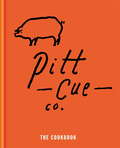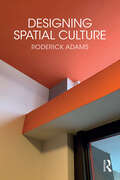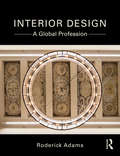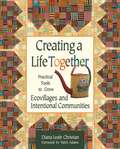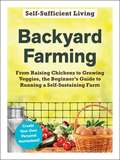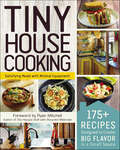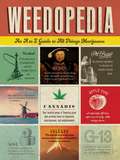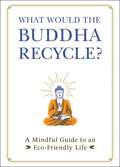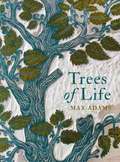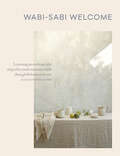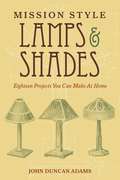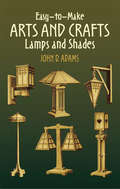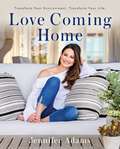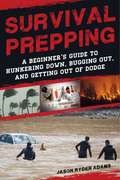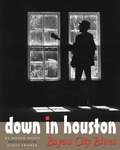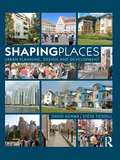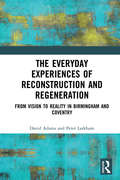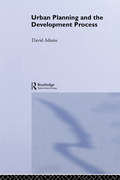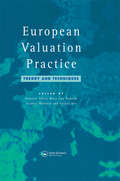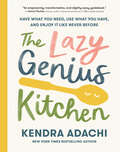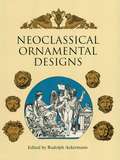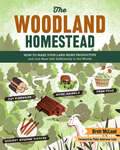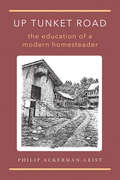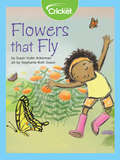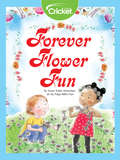- Table View
- List View
Pitt Cue Co. - The Cookbook
by Tom Adams Jamie Berger Simon AndersonWith great recipes for meats, sauces and rubs mixed with ideas for pickles, slaws, puddings and cocktails, plus features on meats, equipment and methods, the Pitt Cue Co. Cookbook is your guide to enjoying the best hot, smoky, sticky, spicy grub all year round.From Pitt Cue's legendary Pickle backs and bourbon cocktails, to their acclaimed Pulled pork shoulder; Burnt ends mash; Smoked ox cheek toasts with pickled walnuts; Lamb rib with molasses mop and onion salad; Chipotle & confit garlic slaw; Crispy pickled shiitake mushrooms; Toffee apple grunt; Sticky bourbon & cola pudding and so much more, it's all irresistibly delicious food to savour and share.
Designing Spatial Culture
by Roderick AdamsDesigning Spatial Culture investigates a powerful experiential dialogue formed between the habitation of space and a diversified cultural realm. This creative proposition binds and positions human activity and experience framing its histories, currency and future. Whilst the book distinguishes between the conditions of the existing urban/ architecture/ interior canon, it embraces a new agency of space, showcasing the encounters, assemblies and designs that shape human behaviours and the cultural forms of the built environment. Using authoritative case studies, the book examines many locations and spaces, ranging from new urban landscapes, historical domestic spaces and contemporary architecture. It embraces the most lavish and flamboyant to the most simplistic and minimal, establishing a connected cultural narrative. The book shifts the focus in the spatial realm from an object-based experience (where space is filled with things) to a more complete immersive experience (combining physical and digital). A key part of this exploration is the relationship between the architecture and the interior which is often the most predominant spatial experience and fundamental to the understanding spatial experience and existing cultures. Without the architectural enclosure, the interior would lose its site context and structure for its existence. Without an interior, architecture would not fully develop an engaging spatial experience for the user. The book rationalises this through extended use of a spatial probe which documents and summarises an evidence-based research project capturing spatial culture data from a predominantly domestic setting. The book is essential reading for students and researchers in architecture, interior design and urban design.
Interior Design: A Global Profession
by Roderick AdamsAs the globe shrinks and the concept of distance diminishes, this text challenges the current status quo by identifying the cohesions and specialisations of design communities across the continents. It sets out an international spatial design landscape, identifying and contouring global design practice and design hotspots from a range of case studies, interviews and design practice perspectives. Using a range of interior environments, the chapters link the origins, trends and perceptions of the interior to create new insight into trans-global design. The book expands, but also coheres the interior design discipline to ensure the subject continues to grow, develop and influence the inhabitations of the world. The book features a wealth of pedagogical elements including: Beautifully designed with over 100 full colour illustrations, photographs and examples of design work Maps and diagrams which highlight hotspots of design across the globe, providing strong graphic information Interview panels featuring professional insights from designers across the globe ‘Employability’ boxes, providing a good tips guide for students gaining employment across the globe ‘International Dimension’ boxes which strengthen the scholarship of studying interior design in a globalised way ‘Design Oddities’ box which brings into focus any new or contextual facts that help contextualise the global interior.
Creating a Life Together
by Patch Adams Diana Leafe ChristianCreating a Life Together is the only resource available that provides step-by-step practical information distilled from numerous firsthand sources on how to establish an intentional community. It deals in depth with structural, interpersonal and leadership issues, decision-making methods, vision statements, and the development of a legal structure, as well as profiling well-established model communities. This exhaustive guide includes excellent sample documents among its wealth of resources.Diana Leafe Christian is the editor of Communities magazine and has contributed to Body & Soul, Yoga Journal, and Shaman's Drum, among others. She is a popular public speaker and workshop leader on forming intentional communities, and has been interviewed about the subject on NPR. She is a member of an intentional community in North Carolina.
Backyard Farming: From Raising Chickens to Growing Veggies, the Beginner's Guide to Running a Self-Sustaining Farm (Self-Sufficient Living)
by Adams MediaGrow, raise, and store your own food with this simple and easy guide to creating a self-sustaining farm right in your backyard!These days we are all looking for ways to become more self-sufficient. Now with Backyard Farming you can create your very own micro farm right in your backyard—no matter where you live! Now you can discover ways to grow, raise, and store your own food year round whether you live in an urban environment, in the suburbs, or out in the country. From raising chickens and beekeeping to growing vegetables and planting fruit trees, this guide to homesteading will help you become more self-reliant in no time!
Tiny House Cooking: 175+ Recipes Designed to Create Big Flavor in a Small Space (Tiny House Living Ser.)
by Adams MediaNo need to curb your big appetite in a tiny home—here are 175 recipes uniquely designed to be made in the micro-kitchens of tiny homes and apartments.Tiny homes are the next big thing—frequently featured in HGTV shows such as Tiny House, Big Living and in popular lifestyle publications such as Good Housekeeping, tiny homes are gaining popularity for their economic and ecological sensibility. But with tiny homes come tiny kitchens—according to the Tiny House Blog, many tiny homes have only two burner stove tops, a mini-fridge, and no microwave or oven. At first glance, this may seem like a challenge, but Tiny House Cooking proves how easy cooking in a tight space can be! Featuring 50 beautiful full-color photos of tantalizing finished recipes and a foreword by tiny house living expert Ryan Mitchell, Tiny House Cooking includes 175 recipes especially designed for the pocket-sized abode—none of the recipes require an oven, microwave, toaster oven, freezer, full-sized refrigerator, or any other extraneous device—as well as information on essential equipment, space-saving ideas, and innovative ways to reduce and recycle creative waste. Find delicious new ideas for breakfast, sandwiches, appetizers, snacks, main dishes, desserts—and more!—all only using two pots at most.
Weedopedia: An A to Z Guide to All Things Marijuana
by Adams MediaDiscover everything you&’ve ever wanted to know about marijuana all in one place with this authoritative A-to-Z guide to cannabis!What&’s a wake and bake? Who is Mitch Hedberg? What does Louisa May Alcott have to do with cannabis? And what exactly is the difference between a bong and a bubbler? Now you can &“weed&” all about it and find all the answers and more with this entertaining and updated edition of Weedopedia, your guide to everything marijuana—from the best movies to watch while high to cannabis slang and terminology. Whether you&’re interested in learning more about all things marijuana, or if you want something entertaining to read while enjoying a toke, this book is the one-stop-shop for all your weed-related needs.
What Would the Buddha Recycle?: A Mindful Guide to an Eco-Friendly Life
by Adams MediaLive the calm and eco-friendly lifestyle you&’ve always dreamed of with this perfect guide to eco-conscious living for anyone who wants to save the planet and make a difference. In today&’s world, there is a lot that can stress us out. We live in a time when talking about climate change is a hot button issue leading to political movements, youth led protests, and lots of anxiety. From green living to figuring out how you (and your family) can make a difference in your community, this mindful approach is the key to being stress-free as you make a positive impact on the environment. What Would the Buddha Recycle? can help you gain a better understanding of how you impact the world around you in your day-to-day life. And, even better, it can help you pause, reflect, and figure out what changes you can make to protect the world. In this book you&’ll learn how to: -Use natural ingredients in your home for cleaning (lemon juice can help your furniture shine) and pest control (chili pepper can deter ants) -Combine mindful cooking and eating for healthier meals that don&’t hurt the environment and make you feel great -Figure out the right food to keep your beloved pets happy and healthy by choosing natural ingredients and avoiding chemical preservatives -Include your family in your new environmentally friendly ways and raise your children to have a similar mindset about saving the planet -And much more! With advice that covers every area of your daily life, What Would the Buddha Recycle? offers easy changes so you can make a difference and protect the environment all while staying zen in the process.
Trees of Life
by Max AdamsAn informative, richly illustrated book about eighty of the world’s most important and remarkable treesOur planet is home to some three trillion trees—roughly four hundred for every person on Earth. In Trees of Life, Max Adams selects, from sixty thousand extant species, eighty remarkable trees through which to celebrate the richness of humanity’s relationship with trees, woods, and forests.In a sequence of informative and beautifully illustrated portraits, divided between six thematic sections, Adams investigates the trees that human cultures have found most useful across the world and ages: trees that yield timber and other materials of immense practical value, trees that bear edible fruits and nuts, trees that deliver special culinary ingredients and traditions, and trees that give us dyes, essences, and medicines. In a section titled “Supertrees,” Adams considers trees that have played a pivotal role in maintaining natural and social communities, while a final section, “Trees for the Planet,” looks at a group of trees so valuable to humanity that they must be protected at all costs from loss.From the apple to the oak, the logwood to the breadfruit, and the paper mulberry to the Dahurian larch, these are trees that offer not merely shelter, timber, and fuel but also drugs, foods, and fibers. Trees of Life presents a plethora of fascinating stories about them.
Wabi-Sabi Welcome: Learning to Embrace the Imperfect and Entertain with Thoughtfulness and Ease
by Julie Pointer Adams“An antidote to the veneer of perfectionism so often presented by books of its kind, Wabi-Sabi Welcome offers readers license to slow down and host guests with humility, intention, and contentment.” —Nathan Williams, founder of KinfolkWabi-Sabi Welcome is sharing a pot of tea with friends. It is preparing delicious food to nourish, not to show off. It’s keeping a basket of cozy slippers at the door for guests. It is well-worn linens, bouquets of foraged branches, mismatched silverware, and heirloom bowls infused with the spirit of meals served with love. In this lush entertaining manual, author Julie Pointer Adams invites readers into artful, easygoing homes around the world—in Denmark, California, France, Italy, and Japan—and teaches us how to turn the generous act of getting together into the deeper art of being together. In this book, readers will find: unexpected, thoughtful ideas and recipes from around the world; tips for creating an intimate, welcoming environment; guidelines for choosing enduring, natural decor for the home; and inspiring photographs from homes where wabi-sabi is woven into daily living.
Mission Style Lamps and Shades: Eighteen Projects You Can Make at Home
by John Duncan AdamsWith its simple, organic charm and timeless natural beauty, Mission-style furniture has enjoyed continued popularity for over a century. For craftsman and non-craftsman alike, perhaps the most cherished examples of Mission-style furniture are lamps. Mission Style Lamps and Shades takes readers through the entire process of designing, planning, and constructing radiant Mission-style lamps and shades. For countless craftspeople, John Duncan Adam’s Mission Style Lamps and Shades has been the go-to guide for those wanting to build their own lamps and shades. The book contains a wide array of do-it-yourself projects, from reading lamps to chandeliers, desk lights to drop lights, complete with easy-to-follow instructions, measurements, and more than 75 diagrams, drawings, and illustrations. With straightforward language, Adams takes the reader through techniques like trimming a block of wood, using a soldering iron, and designing opulent shades with art glass. With Adams’s expert guidance, the beginning craftsman will have no trouble creating a one-of-a-kind, fully functional, decorative lamps and shade.
Easy-to-Make Arts and Crafts Lamps and Shades
by John D. AdamsFashionable in the early twentieth century, Arts and Crafts-style lamps are popular again in the twenty-first century. The elegant simplicity of these useful furnishings will inspire craftworkers to try their hand at the handsome projects described in this instructive manual.First published nearly a century ago, this step-by-step guide--with measurements for sixteen projects--shows how to turn simple, inexpensive materials into a wide range of beautiful and functional Arts and Crafts projects, among them portable table lamps, reading and piano lamps, a dining room dome, a lantern, a shade for a droplight, and wall-hanging lamps, as well as a newel post lamp, and an electric candle sconce.Antique collectors, historians of American style, and lovers of vintage furnishings will also find invaluable information in this collection of now-rare lighting fixtures.
Love Coming Home: Transform Your Environment. Transform Your Life
by Jennifer AdamsLove Coming Home is a guide for readers to envision the home of their dreams and manifest them where they live right now no matter what their budget or living situation.Home is your base. Home is your sanctuary. It&’s where your best life begins. This friendly guide will give you the tools and knowledge, and empower you to make wherever you live—be it rented, owned, or shared—a place where you will absolutely love coming home to. No matter how much or how little someone has at a given moment, we often hold the belief that our actual dream home will be a place we will eventually move to down the road once we&’ve saved enough and worked hard enough to achieve it. We are all striving to discover that perfect place and rarely see the potential in the place we are living in right now. Jennifer Adams, designer and founder of the international home décor company Home by Jennifer Adams®, shares her insider secrets of how you don&’t have to wait. In Love Coming Home, Jennifer combines her professional designer&’s tool kit of proven tips and resources with her inspirational coaching experience, motivating and empowering you to turn your ideas of a dream home into reality by: demystifying the practical and powerful visualization tool, Vision Boards showing you simple steps to define, refine, and align your home projects and ideas into manageable goals inspiring you to let go of restrictions and take action with confidence sharing her top eleven designer&’s secrets, and so much more Jennifer&’s step-by-step, room-by-room, guidance will help you create a welcoming and functioning space that expresses your unique individuality throughout even the smallest to largest of floor plans. Your dwelling can become an environment that supports and inspires you, to be your perfect sanctuary, because home is where your best life begins!
Survival Prepping: A Guide to Hunkering Down, Bugging Out, and Getting Out of Dodge
by Jason Ryder AdamsFood, Water, First Aid, and Self-Defense Tips for Surviving Natural Disasters, Extreme Weather, Pandemics, Biological Threats, Terrorist Attacks, and Riots It could be a fire, flood, hurricane, tornado, or hailstorm. Financial system collapse or bioterrorism. Governmental shutdown or societal breakdown. The world is full of possible threats, and they seem to be coming at us from all sides these days. Jason Ryder Adams covers everything you need to know prepare your home, keep your family safe, and get ready to leave if the worst happens. You’ll learn how to: Prep with children and pets (and do test runs ahead of time)Plan for staying put, sealing yourself in, and leaving depending on the threatChoose and protect a safe location and develop an escape routeDefend your family with self-defense training and firearmsPut together a 72-hour emergency kit, bug-out bag, and first aid kit So don’t panic—prepare! Prepping today is for everyone. Survival Prepping is written for ordinary folks who want to get started on preparing for the worst. Adams shares bug-out plans for every scenario, safety tips, and invaluable checklists for acquiring the right supplies for emergency situations. Survival Prepping will help you ensure your family survives—and hopefully thrives—should a disaster strike.
Art Against Dictatorship: Making and Exporting Arpilleras Under Pinochet
by Jacqueline AdamsArt can be a powerful avenue of resistance to oppressive governments. During the dictatorship of Augusto Pinochet in Chile, some of the country's least powerful citizens-impoverished women living in Santiago's shantytowns-spotlighted the government's failings and use of violence by creating and selling arpilleras, appliquéd pictures in cloth that portrayed the unemployment, poverty, and repression that they endured, their work to make ends meet, and their varied forms of protest. Smuggled out of Chile by human rights organizations, the arpilleras raised international awareness of the Pinochet regime's abuses while providing income for the arpillera makers and creating a network of solidarity between the people of Chile and sympathizers throughout the world. Using the Chilean arpilleras as a case study, this book explores how dissident art can be produced under dictatorship, when freedom of expression is absent and repression rife, and the consequences of its production for the resistance and for the artists. Taking a sociological approach based on interviews, participant observation, archival research, and analysis of a visual database, Jacqueline Adams examines the emergence of the arpilleras and then traces their journey from the workshops and homes in which they were made, to the human rights organizations that exported them, and on to sellers and buyers abroad, as well as in Chile. She then presents the perspectives of the arpillera makers and human rights organization staff, who discuss how the arpilleras strengthened the resistance and empowered the women who made them.
Shaping Places: Urban Planning, Design and Development
by David Adams Steve TiesdellShaping Places explains how towns and cities can turn real estate development to their advantage to create the kind of places where people want to live, work, relax and invest. It contends that the production of quality places which enhance economic prosperity, social cohesion and environmental sustainability require a transformation of market outcomes. The core of the book explores why this is essential, and how it can be delivered, by linking a clear vision for the future with the necessary means to achieve it. Crucially, the book argues that public authorities should seek to shape, regulate and stimulate real estate development so that developers, landowners and funders see real benefit in creating better places. Key to this is seeing planners as market actors, whose potential to shape the built environment depends on their capacity to understand and transform the embedded attitudes and practices of other market actors. This requires planners to be skilled in understanding the political economy of real estate development and successful in changing its outcomes through smart intervention. Drawing on a strong theoretical framework, the book reveals how the future of places will come to be shaped through constant interaction between State and market power. Filled with international examples, essential case studies, color diagrams and photographs, this is essential reading for undergraduate and graduate students taking planning, property, real estate or urban design courses as well as for social science students more widely who wish to know how the shaping of place really occurs.
The Everyday Experiences of Reconstruction and Regeneration: From Vision to Reality in Birmingham and Coventry
by David Adams Peter LarkhamSet within a wider British and international context of post-war reconstruction, The Everyday Experiences of Reconstruction and Regeneration focuses on such debates and experiences in Birmingham and Coventry as they recovered from Second World War bombings and post-war industrial collapse. Including numerous images, Adams and Larkham explore the initial development of the post-Second World War reconstruction projects, which so substantially changed the face of the cities and provided radical new identities. Exploring these cities throughout the post-war period brings into sharp focus the duality of contemporary approaches to regeneration, which often criticise mid-twentieth century ’poorly-conceived’ planning and architectural projects for producing inhuman and unsympathetic schemes, while proposing exactly the type of large-scale regeneration that may potentially create similar issues in the future. This book would be beneficial for academics and students of planning and urban design, particularly those with an interest in post-catastrophe or large-scale reconstruction projects within cities.
Urban Planning And The Development Process
by David AdamsThis text is about the very essence of urban planning in a market economy. It is concerned with people - landowners, developers, investors, politicians and ordinary members of the public - who produce change in towns and cities as they relate to each other and react to development Pressure. Whether Such Change Occurs Slowly And Is Almost Unnoticed, Or happens rapidly and is highly disruptive, a production process is creating a finished product: the built environment. This form of production, known as the land and property development process, is regulated but not controlled by the state. Urban planning is therefore best considered as one form of state intervention in the development process.; Since urban planning would have no legitimate basis without state power, it is an inherently political activity, able to alter the distribution of scarce environmental resources. Through doing so, it seeks to resolve conflicts of interest over the use and development of land. However, urban plans that appear to favour particular interests such as house-builders above others such as community groups provoke intense controversy. Development planning can thus become highly politicized, with alliances and divisions between politicians not always explained by traditional party politics.; These issues are explored with particular reference to statutory plan-making at the local level. The author draws on his extensive research into urban planning and development, making use of recent case studies and examples to illustrate key points. There are four parts. The first explores the operation of land and property markets and development processes, and examines how the state intervenes in the form of urban planning. The second part looks at the people and organizations who play a critical role in shaping the built environment and considers their relationship with the planning system. Specific attention is paid to important actors in the development process, such as landowners, developers, financial institutions, professional advisers and to the variety of agencies in the public sector that aim to promote development. This concludes with discussion of public- private partnerships and growth coalitions. The third part of the book concentrates on local development planning.
European Valuation Practice: Theory and Techniques
by A. Adair M.L. Downie S. McGreal G. VosThe variability of valuation practice within Europe is perceived as a problem within the globalization of property. This edited textbook examines the practice of real estate valuation in selected countries in Europe. The focus is on countries with well developed real estate markets in which both international and indigenous investors are active. The book is aimed at real estate professionals, financiers, institutional advisers, property researchers and students who require a greater understanding of comparative property appraisal techniques applied across Europe.
The Lazy Genius Kitchen: Have What You Need, Use What You Have, and Enjoy It Like Never Before
by Kendra AdachiFrom the New York Times bestselling author of The Lazy Genius Way comes a fresh perspective for getting the most out of your kitchen! &“An empowering, transformative, and slightly sassy guidebook.&”—Jenna Fischer, actress, author, and producer/cohost of Office Ladies podcast You want your kitchen to be the heartbeat of the home, but you&’re overwhelmed and out of breath trying to make it happen. Meals are on a never-ending loop, and you don&’t have time to prepare dinner, much less enjoy it. Popular Lazy Genius expert and bestselling author Kendra Adachi is here to help! Packed with proven Lazy Genius principles, the book will teach you to: • name what matters to you in the kitchen—whether that&’s flavor, convenience, or something else entirely • feed your people with efficiency and ease • apply a simple, actionable five-step process—prioritize, essentialize, organize, personalize, and systemize—to multiple areas of your kitchen, empowering you to enjoy your kitchen the way you&’ve always wanted You don&’t need magical recipes, fancy gadgets, or daunting lists to follow to the letter; you just need a framework that works whether you&’re cooking for one or for twenty. Straightforward, strategic, soulful, and a little sassy, The Lazy Genius Kitchen will turn your hardest-working room into your favorite one, too.
Neoclassical Ornamental Designs
by Rudolph AckermannGraphic artists, illustrators, desktop publishers - anyone in search of elegant classical ornament - will find a wealth of usable material in this handy resource, reproduced from rare 19th-century portfolios. Readers can choose from borders, corners, vignettes, cartouches, busts, ornamental designs, and many other configurations depicting gods and goddesses, mythical animals, floral and foliate motifs, urns, chariots, helmets, angels and cherubs, columns, figures from classical mythology, and more - all in fine-line renderings that convey a sense of timeless elegance and classical ambience. Ideal for adding pictorial interest to book and magazine illustrations, advertisements, brochures, and many other projects, these designs comprise an easy-to-use, copyright-free reference that belongs at the fingertips of anyone wishing to create eye-catching graphics with a classical touch.
The Woodland Homestead: How to Make Your Land More Productive and Live More Self-Sufficiently in the Woods
by Philip Ackerman-Leist Brett McLeodPut your wooded land to work! This comprehensive manual shows you how to use your woodlands to produce everything from wine and mushrooms to firewood and livestock feed. You’ll learn how to take stock of your woods; use axes, bow saws, chainsaws, and other key tools; create pasture and silvopasture for livestock; prune and coppice trees to make fuel, fodder, and furniture; build living fencing and shelters for animals; grow fruit trees and berries in a woodland orchard; make syrup from birch, walnut, or boxelder trees; and much more. Whether your property is entirely or only partly wooded, this is the guide you need to make the best use of it.
Up Tunket Road
by Philip Ackerman-LeistEver since Thoreau's Walden, the image of the American homesteader has been of someone getting away from civilization, of forging an independent life in the country. Yet if this were ever true, what is the nature and reality of homesteading in the media-saturated, hyper-connected 21st century? For seven years Philip Ackerman-Leist and his wife, Erin, lived without electricity or running water in an old cabin in the beautiful but remote hills of western New England. Slowly forging their own farm and homestead, they took inspiration from their experiences among the mountain farmers of the Tirolean Alps and were guided by their Vermont neighbors, who taught them about what it truly means to live sustainably in the postmodern homestead-not only to survive, but to thrive in a fragmented landscape and a fractured economy. Up Tunket Roadis the inspiring true story of a young couple who embraced the joys of simple living while also acknowledging its frustrations and complexities. Ackerman-Leist writes with humor about the inevitable foibles of setting up life off the grid-from hauling frozen laundry uphill to getting locked in the henhouse by their ox. But he also weaves an instructive narrative that contemplates the future of simple living. His is not a how-to guide, but something much richer and more important-a tale of discovery that will resonate with readers who yearn for a better, more meaningful life, whether they live in the city, country, or somewhere in between.
Flowers that Fly
by Susan Yoder AckermanSimon teaches his little cousin Adeline about how to grow a garden that will attract beautiful butterflies.
Forever Flower Fun
by Susan Yoder AckermanThere are so many fun things to do outside during the summer! When the flowers bloom, there is flower fun for everyone! When their hollyhock ladies and daisy chains wilt, Lily Rose and her friend learn how to preserve flowers by drying them. There's always an adventure in nature!
